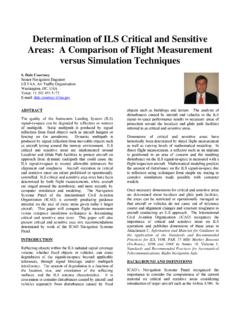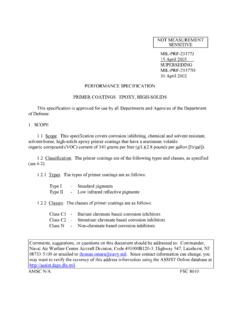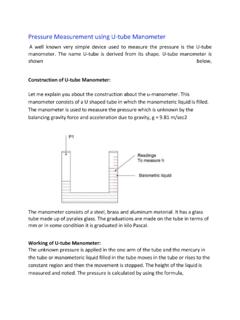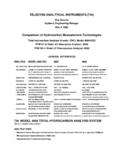Transcription of Sec5 bridgesens Print - Texas Instruments
1 Precision Analog Applications SeminarTexas InstrumentsBridge measurement SystemsSection 5 Precision Analog Applications SeminarTexas InstrumentsBridge measurement SystemsOutline Introduction to Bridge Sensors Circuits for Bridge Sensors A real design: the ADS1232 REF The ADS1232 REF FirmwareThis presentation gives an overview of data acquisition for bridge begin with a discussion of the bridge sensor, and introduce some theory. We then look at actual hookups of bridge sensors to ADCs. The ADS1232 REF is introduced and discussed as an example of a real design. Finally, we briefly discuss the ADS1232 REF s Analog Applications SeminarTexas InstrumentsBridge measurement SystemsA Common Bridge Sensor: The Load CellA load cell is one of the most common bridge sensor types.
2 It can measure most kinds of force, but load cells in weigh scales almost always measure Analog Applications SeminarTexas InstrumentsBridge measurement SystemsThe Strain GaugeThe strain gauge is the sensitive element in load common piece of wire will change resistance slightly when placed under tension. Wire arranged to maximise this effect forms a strain gauge. Strain gauges are typically etched foil patterns glued to a bar of metal or other tensionable a load cell, the strain gauge is placed so that when the cell is loaded, the gauge is strained, changing its resistance change per unit of strain is very small, and requires sensitive circuitry to measure it accurately.
3 (Image from )Precision Analog Applications SeminarTexas InstrumentsBridge measurement SystemsThe Wheatstone BridgeThe Wheatstone bridge is a familiar circuit for measuring resistance very accurately. Invented in 1833 by Hunter Christie, the circuit was later studied by Charles Wheatstone, whose name became attached to the circuit thanks to his extensive analyses of it. Wheatstone also was the first to draw the circuit in the distinctive diamond style used ever principle of the circuit is that if three resistances are known, and the current in the cross branch is zero, the fourth resistance can be calculated.
4 The measurement can be made very accurately since zero current can be detected with extremely high accuracy using a sufficiently sensitive circuit is actually not used in bridge sensors, despite appearances; but it is a direct ancestor of the bridge sensor. Let s now look at the circuits used for measuring sensor Analog Applications SeminarTexas InstrumentsBridge measurement SystemsResistance measurement =1 VVRROE1gThe circuit above shows how it is possible to measure resistance using a voltage divider. VEis called the excitation that the relationship between Rgand Vois a sensor like a strain gauge, this circuit will tend to produce very small changes in voltage, offset by a large amount.
5 These are very difficult to measure if the offset is not Analog Applications SeminarTexas InstrumentsBridge measurement SystemsRemoving the Offset +=21 RRRVVG11 EOThe large offset can be eliminated by adding a voltage divider and measuring the output assumes that Rgat rest is roughly equal to R1, and that all the R1s are very closely matched. Bridge sensors are nearly always built this Analog Applications SeminarTexas InstrumentsBridge measurement SystemsSingle-Point Bridge +=21 RRRVVG11 EOThis circuit is electrically identical to the previous one. This is how bridge sensors are commonly configuration is called a single-point bridge sensor, since a single resistor changes, while the other three are , the output voltage does not change linearly with the changing that this circuit is not really a Wheatstone bridge, since the legs are not connected, and voltage is measured instead of Analog Applications SeminarTexas InstrumentsBridge measurement SystemsTwo-Point BridgeBridge sensors can be made with two varying points.
6 Higher-end load cells are commonly constructed this way, with two strain gauges connected oppositely. This makes the cell twice as Analog Applications SeminarTexas InstrumentsBridge measurement SystemsFour-Point BridgeBridge sensors can also be made with all four elements varying. This is done in cases where a very linear and sensitive output is needed. Matching the elements can be difficult, so this is seldom done in inexpensive Analog Applications SeminarTexas InstrumentsBridge measurement SystemsBridge sensor parameters Sensitivity measured in mV/V; voltage output when the bridge is excited with 1 volt and the sensor is at full scale; 2mV/V is common Accuracy measured in percent; load cells are typically - 1% accurate, due to non-linear output curve Bridge resistance resistance of the bridge measured unloaded across the signal terminalsThree parameters are usually supplied with bridge is the most important.
7 It is nearly always expressed in mV/V. A bridge with 2mV/V sensitivity will deliver 2mV if the measurement is at full-scale and the bridge is excited with 1V. This shows that the signals to be measured are very, very small; a 10V excitation can excite a 2mV/V sensor to at most 20mV!Accuracy is generally rated at the factory. Although the 1% and numbers look abysmal, in practice most sensors can perform better in controlled conditions, especially after calibration and bridge resistance indicates the size of the resistors in the bridge when the bridge is unloaded (idle). Bridge resistances are typically less than 1k.
8 Most bridges measure the same resistance across the excitation terminals. Note that the bridge resistance determines power consumption, which can be rather high; a 10V excitation consumes 20mA for a 500-ohm Analog Applications SeminarTexas InstrumentsBridge measurement SystemsBridge sensor error terms Offset error voltage produced when the measurement parameter is zero Full-scale error difference between the ideal voltage and the actual voltage when the measurement parameter is at maximum Drift change of the above as temperature varies Non-linearity deviation of the output curve from a straight lineBridge sensors have error terms similar to those found on other kinds of error is the voltage produced when the sensor s measurement parameter is zero.
9 This can easily be calibrated error is the deviation in slope from the expected value. This can also be easily is very important: it is the change of the above values with temperature and time. It is much more difficult to compensate for drift especially drift with we have seen, most bridge sensors exhibit an inherent non-linearity, in addition to the non-linearities arising from other sources. This can be corrected for to a degree, but commonly is not, as it is (with a good sensor) smaller than most other Analog Applications SeminarTexas InstrumentsBridge measurement SystemsCalibrationOffset calibration for a weigh scaleBefore offset calibrationAfter offset calibrationNo weight (0kg)This slide and the next illustrate calibration for a weigh this slide, the scale is offset calibrated.
10 Prior to calibration, the scale displays a negative offset. After calibration, with no weight applied, the scale reads zero, as it should.(Note that in the case of an analog scale, calibration can be performed merely by rotating the movement of the gauge.)Precision Analog Applications SeminarTexas Instruments5kg5kgKnown5kgBridge measurement SystemsCalibrationGain calibration for a weigh scaleBefore gain calibrationAfter gain calibrationIn this slide, the scale is shown being calibrated for gain. A known weight is obtained and placed on the scale. The scale is then adjusted until its reading is equal to the mass of the known scale reads too low when the 5kg known weight is placed on it.
















